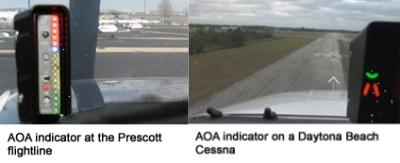Devices Intended To Enhance The Quality Of Flight Education
Embry-Riddle Aeronautical University has installed Angle of Attack (AOA) indicators in its entire fleet of 61 Cessna training aircraft at its Daytona Beach and Prescott campuses.

This action dovetails with a recent report from an FAA/industry panel that recommends the use of AOA-based systems by general aviation as the best method for reducing fatal loss-of-control accidents in the approach and landing phase of flight. Bolstering that conclusion, FAA Administrator Michael Huerta has called on the general aviation community to add AOA systems and other potentially life-saving equipment to their aircraft.
The new Alpha Systems AOA indicator in Embry-Riddle aircraft is a stand-alone aftermarket device installed in the cockpit and on an airplane’s wing. It continually communicates to the pilot, via a grouping of colored lights, the available lift and margin above an actual stall, increasing the precision of the flight, improving stall/spin situational awareness, conserving fuel and building confidence in student pilots.
“This device is a direct measurement of energy; it lets pilots know at a glance how much lift is available regardless of an airplane’s speed and altitude,” said Dr. Jackie Luedtke, Director of the Robertson Safety Institute at the Prescott Campus and associate professor of Safety Science. “This low-cost improvement offers considerable educational value for our students and faculty. It reinforces Embry-Riddle’s niche as a leader in hands-on, applied education as we constantly assess ways to increase our quality of training and education.”
The new devices will give researchers at the Prescott Campus the opportunity to gather detailed data and feedback about the controllability, sideslip and maneuvering effectiveness of Embry-Riddle aircraft with the AOA indicator installed in take-off, landing and emergency situations. During student flights, data will be compiled from aircraft with and without an AOA indicator installed. The ultimate goal of this ongoing research is to determine the best practices and learning methodologies for integrating AOA technology into flight education.

“The benefits of this research will allow us to increase the safety and confidence of our student pilots,” said Dr. Frank Ayers, Prescott Campus Chancellor. “We believe this research will improve upon our stellar safety record and bring a tremendous value to our students, who will have the confidence of learning to fly with such a necessary device.”
At the Prescott Campus, the Cessna aircraft bearing the new AOA indicators include two planes used by the nine-time national champion Golden Eagles Flight Team.
At the Daytona Beach Campus, Alpha Systems originally donated two of its AOA devices to the Eagles Flight Team for installation in the group’s two Maule aircraft last fall. The AOA tool performed so well that the decision was made shortly afterward to equip all 42 Cessnas with the system. Half the cost was defrayed by a $45,000 donation from James C. Ray through his Aviation Education Foundation. “I know this is going to save lives,” the pilot and businessman said.
The installation of AOA devices in the Daytona Beach aircraft was preceded by research that included 30 trial flights supervised by Dr. Albert Boquet, Embry-Riddle associate professor of Human Factors, to determine which AOA display would be most effective and to gather flight instructor feedback on which training maneuvers using the AOA indicators would be most beneficial for student pilots.
Ken Byrnes, chair of the Flight Department at the Daytona Beach Campus, said “Based on the number of loss-of-control accidents that have occurred in aviation, both the NTSB and the FAA have recommended an increased use of AOA indicators. Our initial research shows that using AOA indicators during training improves student knowledge on aircraft performance, especially at slower airspeeds such as those that are required for landing. I have no doubt that using the AOA tool during training will increase the airmanship skills of our graduates and result in an increase in aviation safety.”
 ANN's Daily Aero-Term (05.16.24): Instrument Runway
ANN's Daily Aero-Term (05.16.24): Instrument Runway ANN's Daily Aero-Linx (05.16.24)
ANN's Daily Aero-Linx (05.16.24) Airborne 05.15.24: Ghost Sq MidAir, B-2 Junked, Dream Chaser Readies
Airborne 05.15.24: Ghost Sq MidAir, B-2 Junked, Dream Chaser Readies Airborne 05.10.24: Icon Auction, Drunk MedEvac Pilot, Bell ALFA
Airborne 05.10.24: Icon Auction, Drunk MedEvac Pilot, Bell ALFA Airborne Affordable Flyers 05.16.24: PRA Runway, Wag-Aero Sold, Young Eagles
Airborne Affordable Flyers 05.16.24: PRA Runway, Wag-Aero Sold, Young Eagles




